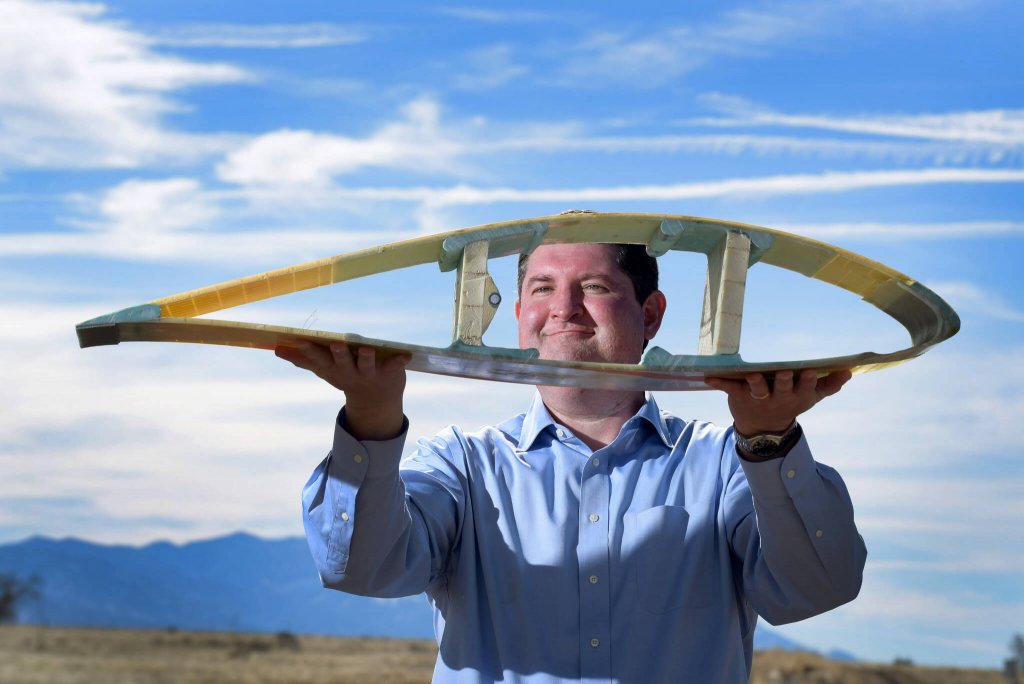The modern worldwide wind industry is at least 30 years old, so you might think most wind-turbine designs have already been optimized and the industry need only plan more projects. Dr. D. Todd Griffith, a member of the technical staff and the technical lead for Sandia National Laboratories’ Offshore Wind Energy Program, disagrees.

Griffith shows a cross-section of a 50-m blade, which is a first step on a path to 200-m blades and 50-MW offshore exascale wind turbines. The design exercise is a DOE ARPA-E-funded program at Sandia National Labs along with University of Virginia, University of Illinois, University of Colorado, Colorado School of Mines, and the National Renewable Energy Laboratory.
To make offshore wind economical, particularly on a large scale, he believes larger turbines with longer blades are still in order.
“The U.S. has great offshore wind energy potential but offshore installations are expensive, so larger turbines will be needed to capture that energy at an affordable cost,” said Griffith. “But beyond 10 or 15 megawatts, conventional upwind blades will be expensive to manufacture, deploy, and maintain.
Most U.S. wind turbines are rated in the 2-MW range, although the largest commercially available turbine is rated at 9 MW, with blades 80 meters long. Impressive, but it is still less than ideal for a large offshore wind farm. So Griffith has begun work with a team at Sandia, which includes numerous university researchers and industry advisers from GE, Siemens, and Vestas.
The challenge: Design a low-cost offshore 50-MW turbine with a blade more than 200 m long — that’s two and a half times longer than any existing wind blade. While a 50-MW horizontal turbine is well beyond the size of current designs, studies show that load alignment can significantly reduce peak stresses and fatigue on the blades. This reduces costs and allows construction of blades big enough for a super-sized turbine.
If anyone is up to the task of designing such a large blade structure, it is Griffith. His research contributions — just to name a few — include work in the areas of turbine blade design, structural dynamics, field testing, and structural health-monitoring methods for wind-power systems. He is an Associate Fellow of American Institute of Aeronautics and Astronautics (he did PhD work at Texas A&M University in Aerospace Engineering), and is a recipient of an AIAA Distinguished Service award for leadership in wind energy.
Griffith has also designed the Sandia 100-m series of blades and is also leading a U.S. national research project that aims to improve design and cost-effectiveness of large-scale floating offshore vertical-axis wind turbines.
Part of Griffith’s success is his ability to think outside the box. To deal with the load alignment of a 50-MW turbine, his project team looked at palm trees and how they sway in storms and high winds. The tree’s segmented trunk is lightweight and follows a series of cylindrical shells that bend in the wind, without losing strength or stiffness. On a wind turbine, a similar load-alignment approach could reduce the mass and forces on blades, making them durable in offshore conditions.
According to Griffith such an “exascale” turbine would also be manufactured in segments for easier transport, and would face downwind when operating. “At dangerous wind speeds, the blades are stowed and aligned with the wind direction, reducing the risk of damage. At safer or production worthy wind speeds, the blades spread out to maximize energy production,” he said.
“Granted, what we are proposing to do here is far beyond current designs and very high risk,” he added. But it is an essential step if it is to be done at all regardless of time frame.
Griffith is dedicated to wind energy and improving current turbine designs. In his spare time, he chairs the ASME Wind Energy Technical Committee, writes research papers, and presents at numerous wind events in Europe and the U.S. If that isn’t enough, he also acts as an adviser and mentor to student interns at Sandia when he is in the lab.
It will be exciting to see how Griffith’s research impacts the offshore wind industry in the U.S. Learn more at http://energy.sandia.gov.
Filed Under: Blades, News, Projects




